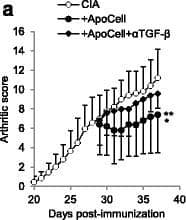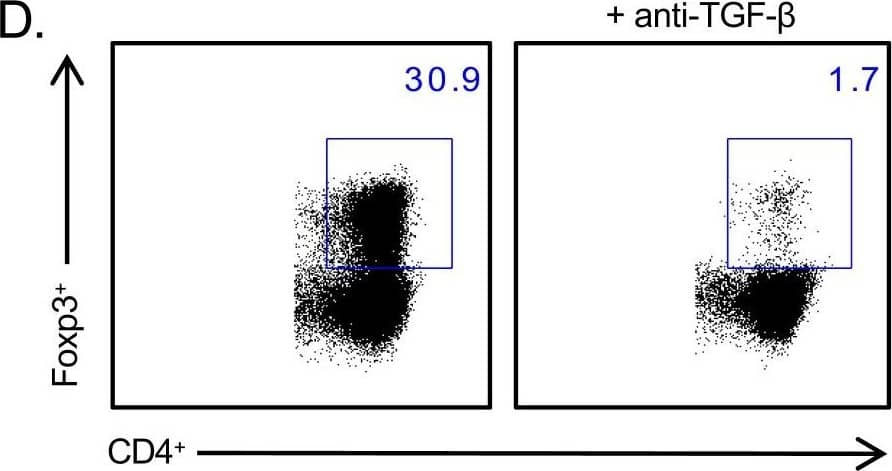TGF-beta 1, 2, 3 Antibody Best Seller
R&D Systems, part of Bio-Techne | Catalog # MAB1835


Conjugate
Catalog #
Key Product Details
Validated by
Biological Validation
Species Reactivity
Validated:
Multi-Species
Cited:
Human, Mouse, Rat, Porcine, Avian - Chicken, Bovine, Canine, Hamster, Mink, Opossum, Primate - Macaca mulatta (Rhesus Macaque), Rabbit, Transgenic Mouse
Applications
Validated:
Binding Inhibition, ELISA Capture (Matched Antibody Pair), Neutralization, Western Blot
Cited:
Activation, Agonist Activity, Bioassay, Blocking, Co-IP, Dot Blot, ELISA Capture, ELISA Development, ELISA Development (Capture), Flow Cytometry, Functional Assay, Immunocytochemistry, Immunodepletion, Immunohistochemistry, Immunohistochemistry-Frozen, Immunohistochemistry-Paraffin, Immunoprecipitation, In vivo assay, Luminex Development, Neutralization, Western Blot
Label
Unconjugated
Antibody Source
Monoclonal Mouse IgG1 Clone # 1D11
Product Specifications
Immunogen
Bovine bone-derived TGF-beta 1 and TGF-beta 2
Specificity
Detects bovine, chicken, mouse, and human TGF-beta in ELISAs and Western blots. It recognizes human TGF-beta 1, TGF-beta 2, and TGF-beta 3. No cross-reactivity was observed with recombinant LAP in direct ELISAs.
Clonality
Monoclonal
Host
Mouse
Isotype
IgG1
Endotoxin Level
<0.10 EU per 1 μg of the antibody by the LAL method.
Scientific Data Images for TGF-beta 1, 2, 3 Antibody
TGF-beta 1 Inhibition of IL-4-dependent Cell Proliferation and Neutralization by TGF-beta 1, 2, 3 Antibody.
Recombinant Human TGF-beta 1 (Catalog # 240-B) inhibits Recombinant Mouse IL-4 (Catalog # 404-ML) induced proliferation in the HT-2 mouse T cell line in a dose-dependent manner (orange line). Inhibition of Recombinant Mouse IL-4 (7.5 ng/mL) activity elicited by Recombinant Human TGF-beta 1 (1 ng/mL) is neutralized (green line) by increasing concentrations of Mouse Anti-TGF-beta 1, 2, 3 Monoclonal Antibody (Catalog # MAB1835). The ND50 is typically 0.25-1.25 µg/mL.Detection of Mouse TGF beta 1/2/3 by In vivo assay
Apoptotic cell-induced immunomodulation in mice with collagen-induced arthritis (CIA) is dependent on transforming growth factor (TGF)-beta. CIA mice that received or did not receive apoptotic cells, with or without anti-TGF-beta blocking antibody were scored daily (a). Data are shown as mean ± SEM of five mice per group from one of two representative experiments; *p < 0.05, **p < 0.01 (Friedman test analysis of variance (ANOVA) with Dunn's multiple comparisons test). Anti-collagen IgG2a antibodies (Ab) were quantified in plasma (b). Data from 5 to 16 mice from two to three independent experiments (no difference, Kruskal-Wallis test ANOVA with Dunn’s multiple comparisons test). Lymph node cells were collected, cultured, and T cell proliferation in response to collagen protein or CD3-specific Ab stimulations was evaluated (c). Data are shown as mean ± SEM from one of two representative experiments; *p < 0.05, **p < 0.01 (nonparametric unpaired t test). Percent and absolute number of Foxp3+ T regulatory cells (Treg) were evaluated in the spleen (d) and suppressive assays were performed by isolating and adding Treg at a different ratio into collagen-specific cultures and responder T cell proliferation was assessed (e). Data are shown as mean ± SEM from one experiment (d Kruskal-Wallis test ANOVA with Dunn’s multiple comparisons test; e Friedman test ANOVA with Dunn’s multiple comparisons test). Plasmacytoid dendritic cells (pDC), conventional dendritic cells (cDC) and macrophages (macro) were isolated and cultured with naïve allogenic T cells to determine Treg polarization (f), and their response to TLR ligand was assessed through evaluation of CD40 costimulatory molecule expression (g). Data from individual mouse plus mean (black bar) from one experiment representative of four are shown; *p < 0.05, ***p < 0.001 (f ordinary one-way ANOVA with Tukey’s multiple comparisons test; g Kruskal-Wallis test ANOVA with Dunn’s multiple comparisons test). BrDU 5-Bromo-2’-deoxyuridine Image collected and cropped by CiteAb from the following publication (https://arthritis-research.biomedcentral.com/articles/10.1186/s13075-016-1084-0), licensed under a CC-BY license. Not internally tested by R&D Systems.Detection of Human TGF beta 1/2/3 by Immunocytochemistry/Immunofluorescence
TGF beta1 stimulates the expression of ECM components in human and rabbit primary cells. (A) Selected ECM mRNA transcripts were measured using qRT-PCR in human RPTEC or human IPF134 following 48 hr stimulation with TGF beta1 (10 ng/mL). Data show transcript abundance relative to the unstimulated control (indicated by the dashed line) and are shown as mean ± SD of four (RPTEC) or seven (IPF134) independent experiments. ****P < 0.0001; ****P < 0.001; **P < 0.01; Student’s t-test. (B) The accumulation of ECM in human RPTEC (i) or human IPF (ii) cells stimulated with 10ng/mL TGF beta1 was evaluated via measurement of the incorporation of 14C-labelled amino acids into the deposited ECM. Data presented are the mean ± SD of three independent experiments. **P < 0.01; Student’s t-test. (C) Increased mature ECM accumulation following treatment of cells with a pro-fibrotic stimulus can be visualised following in-situ fluorescent staining using the Flamingo dye. Cells from three different systems (primary human RPTEC; primary human IPF134; co-culture of primary rabbit RPTEC with primary rabbit renal fibroblasts) were cultured in the absence (top) or presence (bottom) of 10 ng/ml TGF beta1 before decellularised matrix was fixed and stained in situ with Flamingo fluorescent dye. Images show a single field. Image collected and cropped by CiteAb from the following publication (https://pubmed.ncbi.nlm.nih.gov/28855577), licensed under a CC-BY license. Not internally tested by R&D Systems.Applications for TGF-beta 1, 2, 3 Antibody
Application
Recommended Usage
Western Blot
1 µg/mL
Sample: Recombinant Human TGF-beta 1 (Catalog # 240-B) under non-reducing conditions only
Sample: Recombinant Human TGF-beta 1 (Catalog # 240-B) under non-reducing conditions only
Neutralization
Measured by its ability to neutralize TGF‑ beta1 inhibition of IL‑4-dependent proliferation in the HT‑2 mouse T cell line. Tsang, M. et al. (1990) Lymphokine Res. 9:607. The Neutralization Dose (ND50) is typically 0.25-1.25 µg/mL in the presence of 1 ng/mL Recombinant Human TGF‑ beta1 and 7.5 ng/mL Recombinant Mouse IL‑4.
Binding Inhibition
Dasch, J.R. et al. (1994) J. Immunol. 142:1536.
Human TGF-beta 1 Sandwich Immunoassay
Please Note: Optimal dilutions of this antibody should be experimentally determined.
Reviewed Applications
Read 12 reviews rated 4.4 using MAB1835 in the following applications:
Formulation, Preparation, and Storage
Purification
Protein A or G purified from hybridoma culture supernatant
Reconstitution
Reconstitute at 0.5 mg/mL in sterile PBS. For liquid material, refer to CoA for concentration.
Formulation
Lyophilized from a 0.2 μm filtered solution in PBS with Trehalose. *Small pack size (SP) is supplied either lyophilized or as a 0.2 µm filtered solution in PBS.
Shipping
Lyophilized product is shipped at ambient temperature. Liquid small pack size (-SP) is shipped with polar packs. Upon receipt, store immediately at the temperature recommended below.
Stability & Storage
Use a manual defrost freezer and avoid repeated freeze-thaw cycles.
- 12 months from date of receipt, -20 to -70 °C as supplied.
- 1 month, 2 to 8 °C under sterile conditions after reconstitution.
- 6 months, -20 to -70 °C under sterile conditions after reconstitution.
Background: TGF-beta 1, 2, 3
References
- Ayala A. et al. (1992) FASEB J. 6:A1604.
- Roberts A.B. and Sporn M.B., eds. (1990) Peptide Growth Factors and Their Receptors I, Springer-Verlag, 419.
- Dasch J.R. et al. (1989) J. Immunol. 142:1536.
Long Name
Transforming Growth Factor beta 1, 2, and 3
Additional TGF-beta 1, 2, 3 Products
Product Documents for TGF-beta 1, 2, 3 Antibody
Product Specific Notices for TGF-beta 1, 2, 3 Antibody
For research use only
